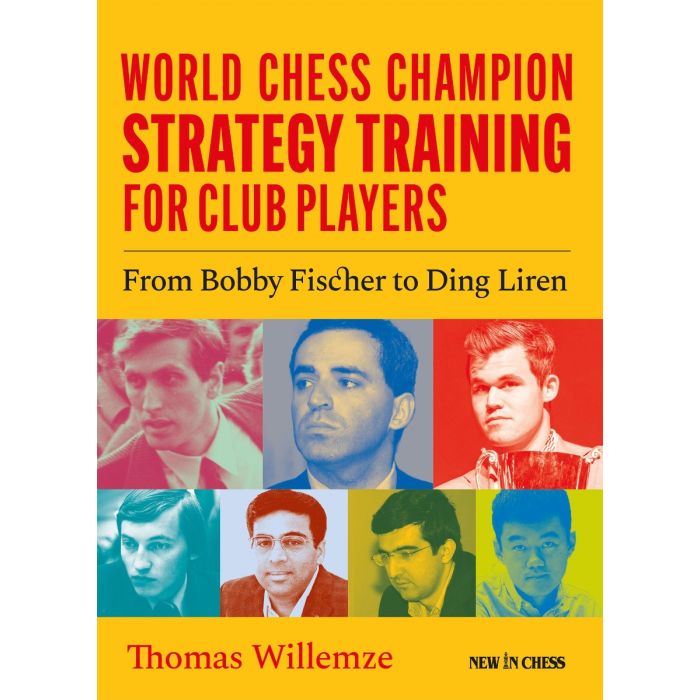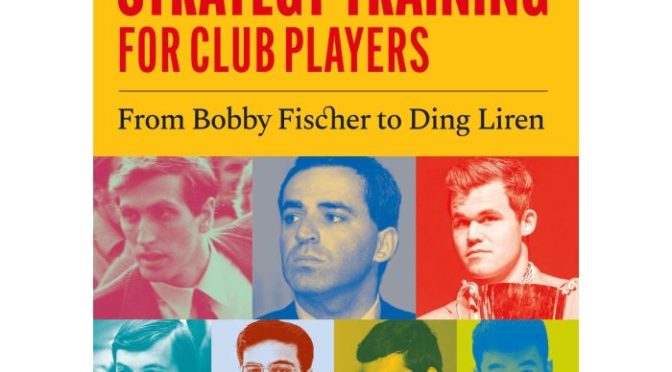From the back cover:
“Chess players can look ahead, formulate a clear plan, and act accordingly. That’s why chess is the perfect learning environment for becoming a strategic expert. But how do you train this? It starts with playing many games and analysing them carefully afterwards.
At the same time, you should learn from the best by studying the games of the world’s strongest players and gradually build their techniques into your play. This book offers you 100 strategic exercises from the games of the best of the best, the World Champions from Bobby Fischer to Ding Liren.
You will learn foundational techniques such as: how to improve your worst-placed piece; how to exploit a lead in development; or make the right piece trade; and how to create a strong square; plus numerous others.
Solving these exercises will help every ambitious club player better understand how to make and execute plans.”
About the Author:
“Thomas Willemze is an International Master from the Netherlands. He is an experienced trainer of amateur players of all levels and has been the National Youth Coach of the Dutch Chess Federation. New In Chess has published his books The Chess Toolbox and The Scandinavian for Club Players and 1001 Chess Endgame Exercises for Beginners – all well-liked by reviewers and customers alike.”

In the introduction to the last book I reviewed, Wojciech Moranda proclaimed: “It is my utmost belief that any author who is seriously interested in helping others excel at chess should treat enriching the public domain with genuinely new training material as a priority.” He adds that “… there is a special rung in hell for authors who shamelessly keep on repeating the same, well-known examples in their books over and over again”.
While I understand where he’s coming from, I don’t entirely agree, and neither, I suspect, does Thomas Willemze. If you’re a subscriber to New in Chess Magazine you’ll know the name from his “What Would You Play?” feature, in which he asks the reader questions taken from amateur games.
Here, though, he introduces his readers to the world champions from Fischer through to Ding Liren, talking about their distinctive styles of play and offering questions concerning strategy taken from their games.
There are similarities and differences with Moranda’s book. While Moranda alternated strategic and tactical questions, Willemze only offers you questions of strategy. While Moranda’s questions give you the chance to play better than the (often very strong) player who failed to find the optimal plan, Willemze’s questions ask you to find the same plan as that chosen by his world champion subjects. Moranda’s solutions are (partially) computer-generated lines showing you what might have happened, Willemze’s solutions show you what happened in the game when the champion opted for the correct plan.
Willemze prefaces each chapter (or ‘part’) with a few pages describing the player’s style and giving a few examples of his play. He’s writing, then, for players who may be less knowledgeable about chess history and won’t have seen most of the positions before. Moranda’s assuming his readers will be well aware of the world champions’ styles and will be familiar with many of their games.
Moranda is writing mainly for very strong and ambitious players with plenty of time available for study.
Willemze is pitching his book at a slightly lower level, ‘club players’ according to the title.
Solving these exercises, he claims, will help every ambitious club player to better construct their own plans in a chess game.
He lists some of the lessons you’ll learn:
- improve your worst placed piece;
- exploit a lead in development;
- make the right piece trade;
- create a strong square;
- discover your opponent’s weakest spot;
- use an open file;
- launch a powerful pawn break;
- open up the position when needed;
Each of the 100 questions is presented in a jumbo sized diagram. Overleaf you’ll discover whether or not you found the solution, followed by a boxed ‘conclusion’ explaining the lesson to be learnt. At the end of each part you’ll find a page of flash cards which you may find useful if you like learning that way.
Let’s turn to a few random examples.
This is Karpov – Malaniuk (USSR Championship 1988). Can you find a way to activate the white bishops?
If you sacrificed the exchange on e7 you found the correct solution.
Here’s the game: click on any move for a pop-up window.
From Miles – Anand (Manila Interzonal 1990): Anand has developed a very powerful initiative on the queenside. What should be his next step?
If you chose Qc8 here, preparing to open up a second front on the other side of the board, you’ve played as well as Anand.
The complete game again:
My final position comes from a Carlsen game you might not be familiar with.
Dourerassou – Carlsen (World U14 Championship Chalkidiki 2003): how, Willemze wants to know, did Carlsen gain the upper hand?
The young Carlsen chose Rd4, to unleash his bishop, appreciating that, once the position opens up it will be superior to the white knight.
You’ll see here what happened next.
Although some of the positions will be familiar to some readers, there are many examples, such as this, from games which will be less well known. Even if you’re very well read, there will be some unfamiliar material here for you.
Willemze has done an excellent job in finding suitable positions for the book, and in offering clear and concise explanations without using reams of computer analysis. This book, I would suggest, is suitable for average or stronger club players, perhaps 1600-2200 strength, with 1800-2000 the main target market. But see what you think from the examples here and in the sample pages.
Production levels are well up to this publisher’s usual high standards, so, if you like what you’ve seen so far, you won’t be disappointed. An enjoyable read which will tell you something about the classical world champions from Fischer through to Ding, and provide you with an array of tools to improve your strategic skills.
You can find out more about the book here and read some sample pages here.
Richard James, Twickenham 21st December 2024

Book Details:
- Softcover: 264 pages
- Publisher: New in Chess; 1st edition (6 Sept. 2023)
- Language: English
- ISBN-10:9083328481
- ISBN-13:978-9083328485
- Product Dimensions: 17.02 x 1.65 x 23.62 cm
Official web site of New in Chess.


